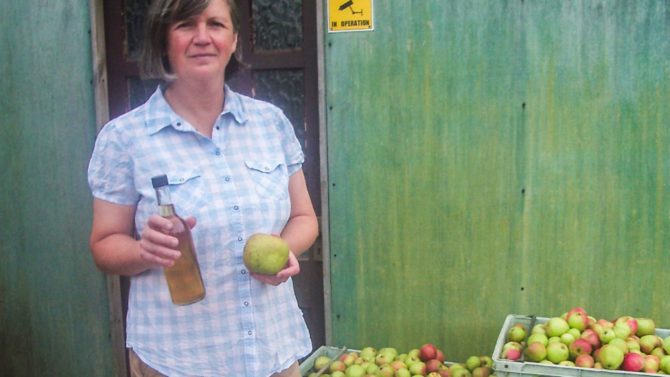Making your own cider in France

If you live in France and are partial to a refreshing cider, this Dordogne-based cider-maker has plenty of advice for how to get started

“You don’t necessarily need lots of land – there is always a place in a French garden for an apple tree, providing blossom in spring and luscious fruits in autumn.” Those are Lorraine Turnbull’s words of wisdom for anyone doubting their ability to grow their own apples in France.
Lorraine was a small-scale commercial cider-maker in Cornwall before she moved to southern Dordogne three years ago. She planted a small orchard (verger) of cider and dessert apple trees in her garden, and now makes a small amount of cider and juice annually for her own needs, She’s also an established author – her books include How to Live the Good Life in France, and her new book, Sustainable Smallholding, was published at the end of 2020.
Grow for it
“In the beginning you will need to source and plant apple trees if you don’t already have one in your garden,” says Lorraine. “Prior to Brexit it was simple to import either young trees or rootstocks from the UK, but the red tape means it may be easier to find suitable apple trees in France.”
“For an average-sized garden you will be looking for trees grown either on MM108 or Franc rootstock. Choose nicely shaped specimens of one to two years old. These will establish in a few years and should not exceed three metres in height when fully grown.”
There are different ways to approach the issue of choosing varieties. Any apple can be used to make cider – Lorraine is a fan of Golden Delicious and British stalwarts Cox and Bramley, which she says both do well in French soil.
You can, of course, choose the variety local to your area, for a more personalised end product and to support local businesses. Or, if you want to make authentic French cider, use dedicated cider apple varieties which are bittersweet and high in tannins.
Ciders are often made using a blend of several varieties to achieve the desired balance of flavours. For more information about the traditional French apple varieties, Lorraine recommends visiting croqueurs-national.fr.

Planting your pommes
When it comes to planting your trees, Lorraine has some tried and tested advice: “Plant the trees in ordinary garden soil, stake them well and protect from rabbits and deer. For each apple tree planted you will need a pollinator of a different variety nearby, either planted by you or in a neighbouring garden, to maximise fruit production.”
Factor in how much maintenance your land will need. If you only plan to have a few trees spread across your garden. it should be a simple case of keeping the grass tidy and weeds at bay; if your heart is set on acres of land with a thriving orchard, you might have to factor in expenses such as garden machinery.
Location can affect how much maintenance your land will need – in damp areas such as Brittany and Normandy your trees will thrive but the grass will grow very quickly.
Just brew it
Within a few years of planting your trees you should have fruit that is ready to be made into cider. There are a few options for how to go about this, but for anyone planning to make cider in small batches for home use, Lorraine’s method is ideal.
“Pick fruit fresh and whole from the tree. If you wouldn’t bite into it, then discard it to avoid any nasty pathogens entering the juice. All fruit must be washed and then ‘scratted’ or pulped to make a porridge-like consistency which is then squeezed to produce juice. For small scale production, you can use a food processor to pulp the apples and then put them through a small table-top press to extract juice.”
If you are using regular eating apples you can allow this liquid to settle, siphon the clear juice out from the apple solids which will collect in the bottle, and store the juice in the fridge for up to three days as a refreshing drink.
Or, you can go on to make cider. “Take the freshly-pressed juice and store in a container such as a demijohn, filled to the shoulders and loosely plugged with a wad of cotton woll,” says Lorraine.
“Store in a cool outhouse or shed and fermentation should start naturally in a few days.” It’s also a good idea to add a cultured yeast (you can buy a specialist cider yeast) to aid fermentation, and some sulphur dioxide to keep bacteria at bay.
“Initially, fermenation is vigorous,” Lorraine explains, “then it slows down after a week or so. This is the time to fit an airlock which allows CO2 to disappear but keeps bugs and oxygen out.”
In a few months the cider is ready to be siphoned and bottled with an inch of space left at the top. “Then pasteurise it in a pasteuriser or bain-marie for exactly 20 minutes at 70 degrees,” says Lorraine. “Using gloves, carefully remove the bottles and lay them on their sides until cool. They can then be stored in a cool place for up to two years.”
Santé!
Lorraine Turnbull’s books can be found here
You can find her on Facebook at LorraineTurnbullAuthor
Share to: Facebook Twitter LinkedIn Email


